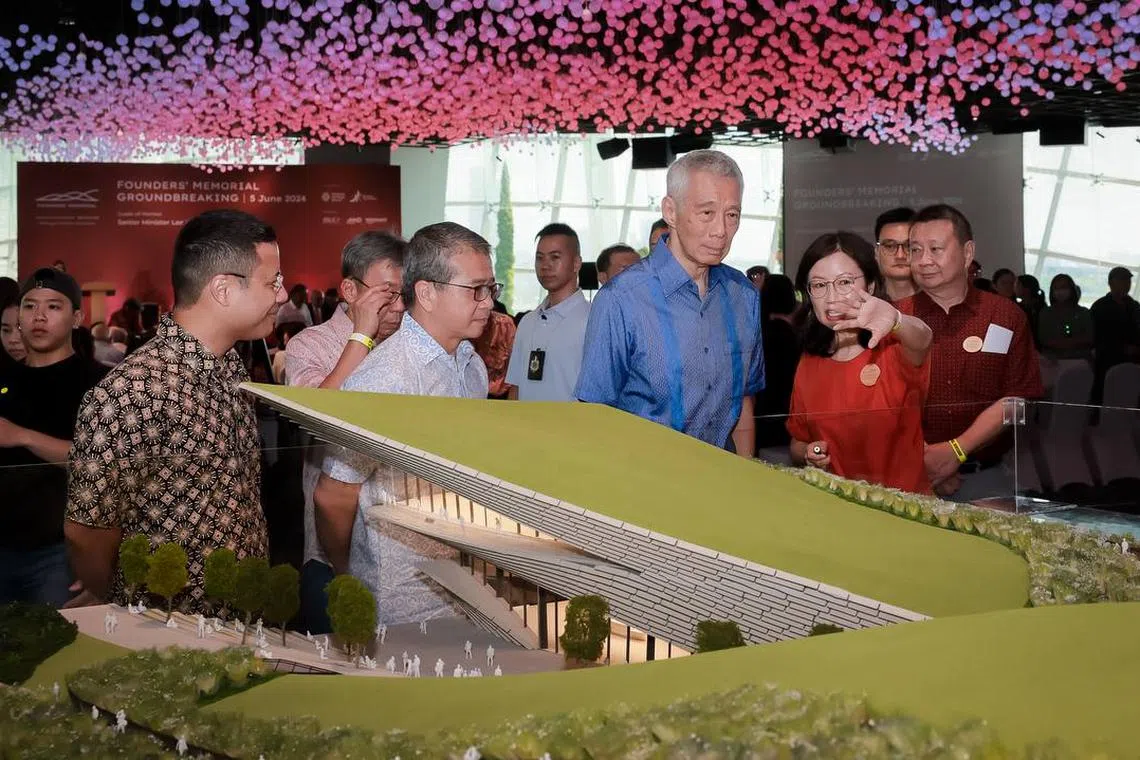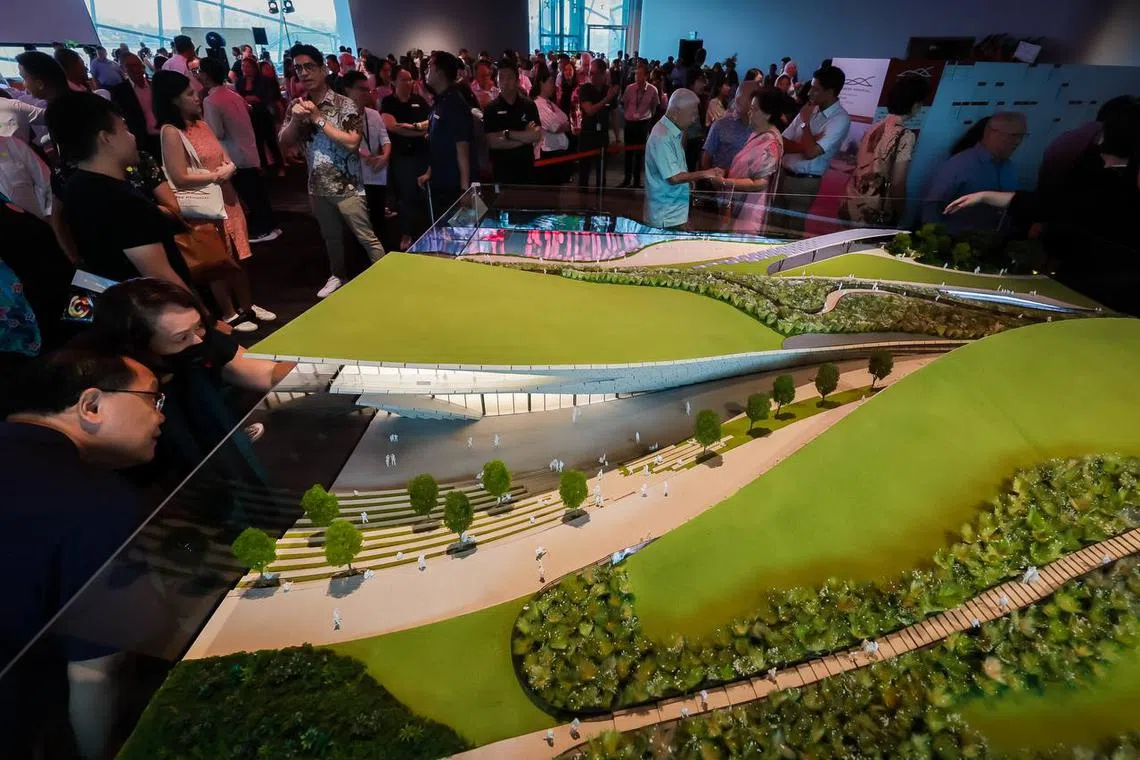Construction of Founders’ Memorial begins, opening slated for 2028
Sign up now: Get ST's newsletters delivered to your inbox

(From left) Minister for National Development Desmond Lee, Minister for Culture, Community and Youth Edwin Tong and Senior Minister Lee Hsien Loong look at a model of the Founders’ Memorial at the ground-breaking ceremony on June 5.
ST PHOTO: GAVIN FOO
Follow topic:
SINGAPORE – Construction of the Founders’ Memorial – dedicated to Singapore’s pioneers and the values they exemplified – has officially started, and it is scheduled to open in 2028.
The memorial at Gardens by the Bay’s Bay East Garden will offer visitors an “integrated gallery and gardens experience”, said the National Heritage Board (NHB).
Within its two two-storey buildings, which will be connected by a common basement, will be a viewing gallery that overlooks Singapore’s city skyline, exhibition galleries, and multi-purpose rooms for workshops and programmes.
NHB said multiple paths will extend from the memorial into the larger Bay East Garden, with the memorial itself designed to depict a path – a symbol of the nation-building journey that Singapore’s founding generation and its leaders undertook.
The ground-breaking ceremony was held at Bay East Garden on June 5, and officiated by Senior Minister Lee Hsien Loong. It was on June 5, 1959, that the first Cabinet of self-governing Singapore was sworn into office.
At a reception held at Gardens by the Bay’s Flower Field Hall after the ceremony, SM Lee said the memorial will tell of how the nation’s founding leaders “overcame the odds to build a strong, united, and independent Singapore”. Stories will capture “how they led the people of Singapore through successive battles”, he said.
“First against colonialism, then communism, and finally communalism; and how they then built a nation based on the values and ideals embodied in the pledge, launching us on the journey that has led to the Singapore that we see today.”
He was joined at the ceremony by Minister for Culture, Community and Youth Edwin Tong, Minister for National Development Desmond Lee and Founders’ Memorial Committee co-chairs Lee Tzu Yang and Tan Tai Yong, as well as community representatives including students, memorial volunteers and donors.
Those who participated in the ground-breaking planted saplings that were grafted from trees planted by Singapore’s leaders during the early years of the nation’s greening journey.
Species planted included the yellow flame (Peltophorum pterocarpum), a native species that was planted by founding prime minister Lee Kuan Yew in 1971 at Tanjong Pagar Community Club; a sea grape (Coccoloba uvifera), planted by Dr Goh Keng Swee in 1975 at Labrador Park; and a sea apple (Syzygium grande), which Mr S. Rajaratnam planted in 1980 at Block 12 North Bridge Road.
The saplings planted on June 5 will be featured in the Founders’ Memorial’s landscaping in the future, said NHB.
The memorial – mooted in 2015
Its design by Japanese architecture firm Kengo Kuma & Associates, working in collaboration with Singapore firm K2LD Architects, was announced in March 2020

The memorial will offer visitors an “integrated gallery and gardens experience”, said the National Heritage Board.
ST PHOTO: GAVIN FOO
NHB said the memorial “aims to inspire Singaporeans to commit themselves towards a better future, as it will serve as a space to capture the spirit of our nation and unify Singaporeans”.
Between June and December in 2024, a mural titled Our Memorial, Our Singapore by local illustration studio 8EyedSpud will be displayed at Bay South Garden, near the Cloud Forest and Flower Dome.
By scanning a QR code that accompanies the mural, people can select activities they are most keen to engage in at the memorial and Bay East Garden – “a continuation of the memorial’s public engagement journey”, said NHB.
They may also leave well-wishes, which may be part of future hoardings for the memorial during its construction.
Mr Lee Tzu Yang said the committee will continue to engage Singaporeans “because the Founders’ Memorial is envisioned as a space owned by every generation, including future generations of Singaporeans”.
Public workshops and a pilot exhibition
More than 900 stories and artefacts have been received for the memorial thus far following a public call, and over 140,000 people attended the exhibition, Mr Lee Tzu Yang said.
A Project Citizens campaign will be launched as part of the engagement to invite Singaporeans to contribute stories about the country’s founding history.
Commemorating the nation-building journey
SM Lee said that besides focusing on key leaders in Singapore’s first two decades of nation-building, the memorial’s project team is curating an installation specially to commemorate the founding generation.
“Through their words and deeds, the memorial will bring alive the values and ideals these pioneers exemplified, championed, and inculcated into Singaporeans,” he added.
Citing the backdrop to Singapore’s independence in August 1965 – the race riots of 1964 and Indonesia’s Konfrontasi – SM Lee said that unlike the independence of other post-colonial nations, the mood in the Republic was sombre.
The founding leaders rallied the population, and Singaporeans, whatever their previous political allegiances, united behind them, said SM Lee, adding that they witnessed various milestones, such as the withdrawal of British forces and the development of the Singapore Armed Forces, as well as housing and educating the people.
Even more importantly, they established fundamental values and ideals that set the country’s long-term direction: democracy, justice and equality, meritocracy and a drive for excellence, an unwavering commitment to honest, clean government and, above all, a multiracial society, SM Lee said.
He added that while the founding leaders did not get everything right, they made the right choices on the most important issues and Singapore succeeded beyond their wildest dreams.
Singapore’s origin story is unique, he said, noting that in the post-war era, many former colonies became independent countries like the Republic.
“But not many successfully shifted from the independence struggle to nation-building, from rousing revolutionary mobilisation to the patient slog of improving people’s lives. Singapore did,” he said.
He added that while Singapore has several memorials that mark significant events in its modern history – the Civilian War Memorial and Kranji War Memorial, for instance – “we do not yet have a memorial to commemorate our nation-building journey”.
“Now, almost 60 years after Separation, and 80 years after the Second World War, the time has come for us to build one,” said SM Lee.
He added: “I hope this Founders’ Memorial will become a space where Singaporeans reflect on our ongoing nation-building journey; appreciate our precious inheritance from the founding generation; and resolve to continue building a harmonious and successful Singapore, based on our foundational values and ideals, for generations to come.”


